TOWARDS A CARIBBEAN CINEMA - CAN THERE BE OR IS THERE A CARIBBEAN CINEMA? ppt
Bạn đang xem bản rút gọn của tài liệu. Xem và tải ngay bản đầy đủ của tài liệu tại đây (228.5 KB, 89 trang )
TOWARDS A CARIBBEAN CINEMA – CAN THERE BE OR IS THERE A
CARIBBEAN CINEMA?
A thesis presented to
the faculty of
the College of Fine Arts of Ohio University
In partial fulfillment
of the requirements for the degree
Master of Arts
Desiree Sampson
August 2004
This thesis entitled
TOWARDS A CARIBBEAN CINEMA – CAN THERE BE OR IS THERE A
CARIBBEAN CINEMA?
BY
DESIREE SAMPSON
has been approved for
the School of Film
and the College of Fine Arts
Ruth Bradley
Associate Professor of Film Studies
Raymond Tymas-Jones
Dean, College of Fine Arts
SAMPSON, DESIREE. M.A. August 2004. Film Studies
Towards a Caribbean Cinema - Can there be or is there a
Caribbean cinema? (89pp.)
Director of Thesis: Ruth Bradley
By first discussing the past and present state of
“Caribbean” filmmaking, the paper will draw on various
theories including those of national cinema, cultural
identity and representation, to make the case for Caribbean
cinema as a cinema of its own. The paper will discuss this
emerging cinema in terms of development of Caribbean styles
and aesthetics, and the role of adaptation of West Indian
literary classics and documentary filmmaking in establishing
such a cinema.
Some of the main scholars and writers whose work will
be referenced include Stuart Hall’s writings on cultural
identity in the black diasporas; Mybe Cham’s work on
Caribbean and African cinema, Benjamin Anderson’s theory of
nations as imagined communities; the Cinema Novo and Cuban
film movements; and interviews with Caribbean filmmakers at
the 2
nd
Annual Festival of African and Caribbean Film.
Approved:
Ruth Bradley
Associate Professor of Film Studies
4
Table of Contents
Introduction 5
A History of Cinema Culture 9
An Overview of Caribbean Cinema throughout the years 14
Why should there be Caribbean cinema? 22
What is/should be Caribbean Cinema? 32
Interview with Mbye Cham 44
Cinema Novo & Cuban Cinema as Models for Caribbean
Cinema 52
Interview with Antiguan filmmakers Howard & Mitzi Allen 61
In Closing 79
Bibliography 84
Appendix A: Report on the 2nd Festival of African and
Caribbean Films held in Barbados in October 2003 87
5
Introduction
Arguably, cinema can serve as a captivating journey
into the past, a glimpse into the history of a culture,
country or group of people. Moreover, as a technological art
capable of capturing present moments in time and
“representing” those moments for all to see, cinema is part
of our present and made up of the culture it represents.
Cinema not only reflects the culture it comes out of but
also has the power to affect that culture. Thus, cinema
functions as a mirror to a culture and that culture in turn
can mirror what is seen in films. It is therefore all the
more important that the portrayal of a particular culture
(or group of people) in cinema express the true
sensibilities of that culture. According to writer Dudley
Andrew, cinema is a “good index of culture” because it
“visibly partakes of the stuff of cultural life” (Andrew,
2). Films present situations and solutions, which can be
seen as social solutions for issues facing the cultural life
that it represents. The question then is should one culture
sit by and allow another to shape its social life through
the pervasiveness of one dominant cinema (and by extension
one dominant culture)?
Among the issues discussed at the Transafrica forum
2001 in Washington was the status of Caribbean cinema. It
was noted that while films and videos of African cinema have
6
been played at festivals worldwide and have found a
promising market, the same fate has not befallen Caribbean
film/video works. At the 2003 meeting of this conference,
the issues addressed included: the scarcity of resources
available to the Caribbean filmmaker (Cuba is the
exception); the responsibility of the filmmakers with
regards to the images they present of the region; the
possibility of Caribbean films achieving commercial success
without compromising the region’s culture; and film as a
development tool. Thus, Caribbean cinema still struggles to
carve a niche for itself and at present can best be
described as an emerging cinema. Indeed, when one thinks of
Caribbean cinema filmmaking from the Latin American regions
usually come to mind, thereby limiting the diversity of the
region. For, the Caribbean is also made of the West Indian
islands such as Jamaica, Trinidad and Tobago, and Antigua
and so on, including the French territories of Martinique
and Guadeloupe, as well as, countries such as Guyana and
Surinam. It is primarily these nations that this paper
specifically addresses when speaking about Caribbean cinema,
though not overlooking the works of the other countries such
as Puerto Rico and Cuba.
The Caribbean has been traditionally defined as
primarily English-speaking nations in the Caribbean Sea
namely:
7
i. the CARICOM (Caribbean Community)states of Antigua-
Barbuda, Bahamas, Barbados, Belize, Dominica, Grenada,
Guyana, Jamaica, Montserrat, St. Kitts-Nevis, St. Lucia, St.
Vincent & the Grenadines, and Trinidad & Tobago;
ii. the US Virgin islands;
iii. the British Virgin Islands, Anguilla, Cayman Islands
and the Turks and Caicos.
However, the ever changing nature of the region has led to a
definition of the Caribbean that is geographically and
historically broader that has been. Thus, the definition of
Caribbean now includes the above-mentioned countries,
Suriname (Dutch speaking), Haiti (French speaking), Cuba,
Dominican Republic, and all other dependencies of the United
States, Britain, France, and the Netherlands.
The language in the Caribbean is cosmopolitan in nature
not simply because of the different European languages from
the colonizers. There is also the mixing of these European
languages with the Native American languages and African
languages brought by the slaves. The result of this mixture
is the local patois and Creole languages that are unique to
the Caribbean as a whole, and to each of the individual
nations. The diversity of the region also exists in the
racial composition of the people of the region. The
Caribbean person has often erroneously been assumed to be a
person of African descent. On the contrary, the Caribbean is
8
made up of Africans, East Indians, Asians, White Europeans
and descendants of Native Americans (the Caribs and
Arawaks). Furthermore, there is mixing and inter-marrying
among the races giving rise to new terms to refer to persons
of mixed racial heritage. And this diversity is represented
in any one nation of the Caribbean. For example, the twin-
island republic of Trinidad and Tobago is comprised of
approximately 40% Africans and 40%-45% East Indians, with
the remaining population comprising Chinese, Syrians,
Americans, and other Europeans (Welcome to the Caribbean
website). There is thus, a sense of hybridization of
Caribbean people which would inevitably extend to the arts,
including cinema. More importantly with this kind of
diversity in the Caribbean there exists the potential for
Caribbean cinema to be a model for a multicultural world
cinema.
9
A History of Cinema Culture
Cinema came to the Caribbean and the Third World for
that matter in much the same as any other import from the
West did; it was brought as yet another product to be
marketed for profit in the lesser developed and lesser
empowered regions of the world. The magic of the silver
screen had become a form of mass entertainment in the
America and Europe. And, with urban folks hungry for what
the cinema had to offer filmmaking in these continents soon
became industrialized. With the capital necessary to do so,
the cinema industry in the West developed systems to support
production, exhibition and distribution of films. From the
period of the mid 1920s to 1950s Hollywood and its highly
organized system of production, exhibition and distribution
would not only rise to become the world’s leading producer
of films, but would also dominate all things cinematic both
at home and abroad. With its aspirations for greater profit,
Hollywood would expand its investments to the Third World
regions. Studios and production houses began to appear in
places like Cuba and Brazil from as early as the 1920s and
in Asia around the 1950s. Much of the production, exhibition
and distribution were foreign controlled and filmmaking in
these regions was in a state of gross underdevelopment
compared to the West. Yet, it was a start by these cultures
to create their own images a start, which the Caribbean
10
region did not get around to until decades later. In fact,
since the later growth and establishment of cinema in
developing countries coincided with the political
independence and economic growth resulting from the end of
WWII, it is no wonder that filmmaking got a late start in
the Caribbean. Indeed, many of the West Indian islands did
not gain independence from their colonizers until much later
than the majority of the Third World did. For example, while
the Dominican Republic gained its independence as early as
1844 and Cuba in 1898, independence for other Caribbean
countries did not start until 1962 when Jamaica and
Trinidad& Tobago were liberated.
Cinema in the Caribbean islands (often referred to as
“pictures” or “theatres” in the West Indian islands) served
as a major means of contact for the islands with the outside
world. There was great excitement and anticipation by the
people, about seeing the latest “picture” even though the
images on the screen were not reflective of their own lives.
So from as early as the 1940s to 1960s cinema and cinema-
going was a strong force in the Caribbean. And the effect of
movie-going on the people and the culture was clearly
evident. Men would often mimic the actions of the cowboys
and gunfighters of the Western; a genre that to this day is
still highly popular among the male population. Numerous
local steelbands took their names from some aspect of
11
American films, for example: Desperadoes, Casablanca and
Invaders steelbands. Such mimicry extended to the social
behavior of the people with both men and women imitating the
fashions, styles and behaviors of famous movie stars, some
even acting out scenarios from the films of their favorite
stars. This credibility and authenticity that Caribbean
people attached to foreign films was, according to Warner,
because the films were just that - foreign. “The formula is
simple: foreign equals good; local equals bad and the
power of the imported film made the average Caribbean viewer
firmly believe that what was portrayed was gospel” (Warner,
50-51). With struggling economies and limited personal
resources to travel and visit other places Caribbean people,
at that time, had little choice than to believe that what
they saw on the silver screen was a true reflection of the
world. However, even though it would be decades later before
many Caribbean countries would attempt to make their own
fiction films, documentaries and newsreels were actively
being made in the region in prior to the 1960s. Many of
these were of the government informational and educational
type yet were still examples of Caribbean cinematic works
being made by Caribbean people.
This is not to say that the Caribbean’s presence was
not evident in these films that came from abroad. The
Caribbean region with its warm climate, white sand,
12
beautiful beaches and “happy-go-lucky” people has been
present in films longer than films have been present in the
Caribbean or than the region has been making its own films.
The extent of that involvement, besides as a consumer and
receiver of these foreign productions, has been as an exotic
location for European and American productions. Island in
the Sun (1957) and The Mighty Quinn (1989) are but a few of
the many films that were conceived outside of the region but
exploited the region’s locale for its look and appeal. Such
productions did little to represent the true essence of the
racial, cultural, geographic and linguistic diversity of the
region and the issues facing the people who live there. The
initial presence of Caribbean people/characters in films
began with entertainers who were given small cameo roles in
some of these foreign films. According to Warner, this
presence of a recognized local personality “in a medium they
considered beyond their reach,” increased the appeal of the
films but by no means made such a film an example of
Caribbean cinema (51).
Caribbean cinema was not and still isn’t a definitive
film movement as say, Cinema Novo was. A film movement
should comprise filmmakers, an audience and other persons
who share similar needs or desires and wish to see such
needs met on the cinema screen. Filmmakers who share similar
views on how things should be filmed, what should be filmed,
13
what devices should be avoided and which ones should be
utilized and who pursue such a vision as a collective body
are the driving force of any film movement. Furthermore,
some sort of an economic support base, whether private or
government, is evidenced in a film movement. Since it lacked
all of these above mentioned characteristics, Caribbean
cinema (outside of Cuban cinema) is not yet a definitive
film movement. It is clearly though a reflection of the
Caribbean (more so the West Indian) people’s search for
their own identity and to have that identity reflected in
all forms of art or expression.
14
An Overview of Caribbean Cinema throughout the years
Most of the films discussed as Caribbean cinema,
especially those coming out of the West Indian islands, were
made around the 1970s to 1990s with new works as recent as
2003. In Cuba there was more of a film industry and film
movement to speak of than there was in the other Caribbean
territories. Film production in Cuba began as early as the
1920s, but the films were products of Hollywood companies
operating out of Cuba. However, Cuba would then take what
its colonizers had brought in and turn it into their own by
starting its own film culture in 1959 with the establishment
of the Cuban Film Institute, ICAIC. These early films were a
result of and reflected the changes and upheavals in social,
political and economic conditions in Cuba. It was initially
a cinema of revolution dedicated to decolonization and
breaking free from the long dominance of Hollywood style of
studio filmmaking and structured narratives. The films of
Tomas Gutierrez Alea, Humberto Solas and Pastor Vega not
only helped build the foundation of Cuban cinema, but also
became renowned worldwide. Memorias del subdesarrollo
(Memories of Underdevelopment) 1968, Lucia 1969, and Retrato
de Teresa (Portrait of Teresa) 1979 are among Cuban films
that have been shown in many international arenas.
15
The small but increasing body of filmmakers from the
other Caribbean islands, such as Horace Ove (Trinidad),
Raoul Peck and Elsie Haas (Haiti), Felix de Rooy (Curacao)
and Yao Ramesar (Trinidad), often makes most of their films
outside of the Caribbean. Many of these films though they
receive critical acclaim in other parts of the world, are
rarely shown in the Caribbean. Nevertheless, there is a body
of work to speak of as Caribbean cinema and this can only
grow with efforts of new filmmakers such as Howard and Mitzi
Allen from Antigua. The start of the 1970s saw Caribbean
productions coming primarily from the French Antilles,
Guadeloupe and Martinique with the film Le Retour made by a
Guadeloupe student in France. A twenty-minute black-and-
white short, this film dealt with the theme of Caribbeans
living the experience of exile in the large cities of the
developed world. Such a theme would recur in many films that
followed as many of the noted Caribbean filmmakers have
produced their work outside of the region while living in
“exile.” Christian Lara, who probably has made the most
films coming out of Guadeloupe, began his work with Coco la
Fleur Candidat (1978), one of the first films to use Creole.
Here, Lara uses a story about a political election to
explore the political situation in Guadeloupe at the time.
Surinam’s contribution to cinema also began in the 1970s
with such films as Pim de la Parra’s Wan Pipel (1976) a
16
story of an African Surinamese student in Holland who
returns home to tend to his sick mother and falls in love
with a Hindu woman. The film makes use of three languages
indigenous to the country as it explores themes of
prejudice, relationships and racial and cultural diversity
in a somewhat comedic environment.
The most successful film of the decade and one of the
two most celebrated films (as far as international
recognition) to come out of this part of the Caribbean was
Perry Henzel’s The Harder They Come (1973). Shot on location
in Jamaica, The Harder they Come with its documentary type
look provided a more realistic portrayal of the culture,
life and issues facing 1970s Jamaicans. Set amid shantytowns
and the pulsating rhythms of reggae music, the plot revolves
around the protagonist Ivan, a country boy who comes to the
city with illusions of becoming famous. Seen by many as a
hard-edged Jamaican gangster film based on the real-life
story of Jamaican outlaw Rhygin, The Harder They Come was
criticized for its stark portrayal of the nation’s crime and
violence at a time when the country was trying to develop
its image as a tourist destination. However, it is to
Henzel’s credit that he avoided the romantic images of
Jamaica found in many Hollywood productions and remained
true to his ideal of allowing the people to see themselves
and their island through their own eyes.
17
Filmmaking in Jamaica and the region continued on into
the 1980s with such productions as Rassoul Labuchin’s Anita
(Haiti, 1982) and Felix de Rooy’s Almacita di Desolato
(Curacao, 1986). Of de Rooy’s dozen or more films, Almacita
di Desolato stands as one of his most creative and widely
recognized. The film, shot on location in Curacao and
utilizing the native language of Papiamentu, reveals de
Rooy’s skills as a painter in its story of struggle between
forces of creativity and destruction. Like de Rooy, Labuchin
in this his first film Anita, also makes use of his creative
background (that of a poet) to explore themes of education,
domestic work and servitude in his landmark film that won
both local and international acclaim. Furthermore, the
film’s unique distribution methods as a result of heavy
censorship marked “a turning point in the history of Haitian
cinema, breaking from the stifling commercial network to
build a real audience among the masses ” (Lafontant-
Medard, 92).
Perhaps the most well known filmmakers to come out of
Haiti are Raoul Peck and Elsie Haas, both of whom operate
outside of their native island. Haas’ repertoire includes La
Seconde Manche (1979), La Ronde des Tap-Tap (1986), La Ronde
des Vodu (1987) and No Comment (1988). La Ronde des Vodu
(“The Vodu Dance”) has gained international recognition for
18
its balanced and more critical look at this ancient religion
that has not been properly treated in films by such
filmmakers as Maya Deren. In dealing with the place Vodu has
in the culture, history and politics of Haiti, the film
creates “a fairly comprehensive and moving portrait of a
society and people struggling to negotiate a legacy of
oppression and denial ” (Cham, 28). Filmmaker Rassoul
Labuchin has described Raoul Peck’s Haitian Corner, as “the
best ever made by a Haitian” (Cham, 29). Haitian Corner,
shot on the streets of Brooklyn, deals with the misuse of
power and its effect on others, and how those affected by
such abuse learn to deal with and overcome feelings of
revenge and anger. It is a clear critique of the abuses many
Haitians underwent at the hands of the Duvalier regime and
is an example of diasporic filmmaking. Haitian Corner has
been viewed by large audiences in Haiti and worldwide and
Peck himself has become a filmmaker of worldwide acclaim.
Caribbean filmmaking during the 1980s resulted in the
second of the two most successful and widely known films to
come out of the region, Rue Cases-Nègres (1983) by Euzhan
Palcy. Rue Cases-Nègres (“Sugarcane Alley”) is an adaptation
of a novel by Joseph Zobel and like her fellow island
filmmakers, Palcy avoids the usual exotic, “island” imagery
and sets the film in the real environment of the people.
Simple in its style even down to the use of sepia tones, Rue
19
Cases-Nègres was true to the spirit of the novel and the
spirit of the Martniquan (and by extension the Caribbean)
culture, particularly in Palcy’s use of Creole throughout
the film.
Documentary films were also being made in the smaller
Caribbean islands during the decades of the 1970s and 1980s.
With the help of UNESCO, many Caribbean states were provided
with video production equipment and training. One
independent company, Banyan, from Trinidad and Tobago, was
able to orchestrate the production of thirteen documentaries
and regional subject matters, and ten profiles of Caribbean
artists (Paddington, 379). These documentaries were
broadcast regionally through the Caribbean Broadcasting
Union (CBU), an organization aimed at distributing
programming of its member states. While there were other
documentaries produced by other countries (Jamaica, Antigua
and Barbados) Banyan rally led the way in quality and volume
of production. Such note documentaries, which reflected some
similar themes as Cuban documentaries, include Crossing Over
(1988) by Trinidadian Christian Laird. Laird’s film was a
sensitive documentary about the experiences of two
musicians, one from Trinidad and the other from Africa, as
they visited each other’s country.
Though the 1970s and 1980s produced the bulk of the
body of work that is considered Caribbean cinema, some new
20
works have emerged in this new millennium. These include:
Stephanie Blacks’ Life and Debt (2001), a critical and
provoking documentary on the damaging effects the policies
of the World Bank and The International Monetary Fund has
had on Jamaica; The Sweetest Mango (2000) and No Seed
(2001), two feature films by a husband and wife team living
and making films in Antigua.
This brief overview is a clear testimony that there is
or has been such a thing as films made by Caribbean people
about Caribbean people. However, there is still some debate
about whether there is such a thing as Caribbean cinema.
At the second installment of the Annual Festival of African
and Caribbean Films hosted by the University of the West
Indies in Barbados, there were mixed but similar views by
filmmakers about Caribbean cinema. Haitian-born filmmaker
Elsie Haas feels that the concept of Caribbean cinema is not
structured enough, that there is no globalization of the
concept. As a result she wouldn’t say that her film La Ronde
des Vodu is Caribbean cinema, though in many circles it is
considered as such. However, she does feel that her film and
others like Henzel’s Harder They Come exhibit a Caribbean
sensibility. In Ex-Iles: Essays on Caribbean Cinema edited
in 1992, Mbye Cham referred to Caribbean cinema as is “un
cinema au rez-dechaussee des negres” (“a cinema at the
basement of cinema of blacks”). At the 2003 film festival in
21
Barbados Cham feels that Caribbean cinema is still emerging
and that one cannot speak of a film industry in the region
yet. He feels, though, that while there is no formal
definition or singular style of Caribbean cinema, there is a
cultural sensibility that one can look at and begin to say
that this is something typically Caribbean. New filmmakers
Howard and Mitzi Allen, who have already produced two
feature films in Antigua, feel that there is a Caribbean
cinema. Indeed, this writer also feels the body of films
that constitute Caribbean filmmaking and the recent film
festival efforts in Barbados, indicate that there is a
Caribbean cinema. However, this cinema is in a state of
infancy. What then is needed to bring this Caribbean
filmmaking out of the basement of cinema and into the
mainstream of society, particularly the society it comes out
of is the subject of the fifth chapter of this document.
Before that this discussion there is, in the next chapter,
the argument for the need for a Caribbean Cinema as a cinema
of its own.
22
Why should there be Caribbean cinema?
In attempting to address the question of is there/can
there be a Caribbean cinema one must first address the
notion of national cinema. With globalization and the
crossing of boundaries and mixing of cultures, the question
of can national cinema exist must be discussed when looking
at culture or region specific cinema. The notion of national
cinema prior to the 1980s was primarily a label used to
categorize cinemas that were culturally different from those
the dominant Western cinema (Hollywood and European cinema).
The term “national” also indicated a territorial context
with which to view these cinemas that exhibited certain
characteristics with which to read and interpret their
films. Thus there existed Soviet socialist realism, German
expressionism and Italian neo-realism as just a few examples
of cinemas defined by the means of expression specific to
the territory and culture they came out of. One of the
criticisms of the notion of national cinema is that it
homogenizes any cinema labeled as such and limits what that
cinema can produce. These conventional notions of national
cinema, thus, overlook the heterogeneity that exists in not
only the content of the films made but in the manner in
which they are made and distributed.
I argue that the unity and wholeness that the concept
of national cinema imposes can provide a useful starting
23
point for persons on both sides of Caribbean cinema that is
those who make the films and those who analyze the film. By
pointing toward a set of elements common to the films one
can begin to give shape and form to Caribbean cinema or any
such cinema that is emerging and in a state of infancy. From
there one can then begin to look at the variation and
heterogeneity within that cinema thereby acknowledging the
dynamism within that cinema. Andrew Higson raises the point
that there is no single accepted discourse on national
cinema and that instead of the term being used to describe
the cinema it is used prescriptively, thus limiting and
containing the boundaries of that cinema (Higson, 36).
However, writer Benedict Anderson, in his notion of
nationalism has put forward more useful theories which (I
argue) can be extended to view and frame the idea of
Caribbean Cinema. Anderson proposes a theory of nationhood
that speaks of nation as an “imagined community.” By
imagined he suggests that though people belonging to the
smallest of nations may never come face to face with or know
most of their fellow members, each one still has in his/her
imagination the notion of nation. The nation is an imagined
community because “regardless of the very real inequities
and injustices that exist in society, it is always perceived
as deep and horizontal comradeship” (qtd in Hill, 143). Thus
communities, for Anderson, are to be distinguished by the
24
manner in which they are imagined. This idea of an “imagined
community” sharing many commonalties in the minds of its
members can be seen in the implicit commonality of
histories, aesthetics political, social and cultural
experiences of countries of the Caribbean. In Latin America
where cinema was largely defined through its expression of
underdevelopment, “national cinema” is viewed as a regional
alternative to films from the United States and Europe, as
well as “a cumulative history” (Cham, 2). This concept
allows for the conceptualization of both cultural
similarities (within a regional and geographical context)
and social and cultural differences (within a political
context). Therefore, the region itself can provide the
narrative space for a beginning framework for looking at
Caribbean cinema as a national cinema. In other words, the
region and its similarities can be taken as the primary
context for enunciation, and from there one can then
acknowledge the differences that are also part of it and
therefore its films. Furthermore, the notion of imagined
communities allows for a more dynamic rather than a static
notion of Caribbean cinema as the idea lends itself to
changing identities, migration of peoples and crossing of
boundaries that is common today. It will extend the
Caribbean beyond the islands washed by the Caribbean sea to
include the Caribbean diaspora; places where Caribbean
25
people have migrated to and formed a community for example,
the east coast of America, Canada and England.
Stuart Hall also sees the validity of exploring the
homogeneity in the region for shaping a Caribbean cinema. In
speaking about cultural identity and representation, Hall
highlights two ways of thinking about cultural identity. The
first position would define the Caribbean identity in terms
of “one shared culture, a sort of collective ‘one true
self’, hiding inside the many other, more superficial or
artificially imposed ‘selves’, which people with a shared
history and ancestry hold in common” (Hall, 220). This
oneness is for Hall the true essence of “Caribbeaness” which
a “Caribbean or black diaspora must discover, excavate,
bring to light and express through cinematic representation”
(Hall, 221). This first perspective looks at transforming
the cinematic representation of the black/Caribbean subject
by visually reconstructing the unity that all Caribbean
people have. Though Hall seems to address only the black
Caribbean person, I extend his sense of oneness to Caribbean
people of all races. For, all of us in the region share a
collective identity as Caribbean people and it is this
identity that we must discover and bring to the cinema
screen. Hall’s second perspective seeks to acknowledge the
significant difference which constitutes “what we are” and
“what we have become” (Hall, 223) as Caribbean people. It is









